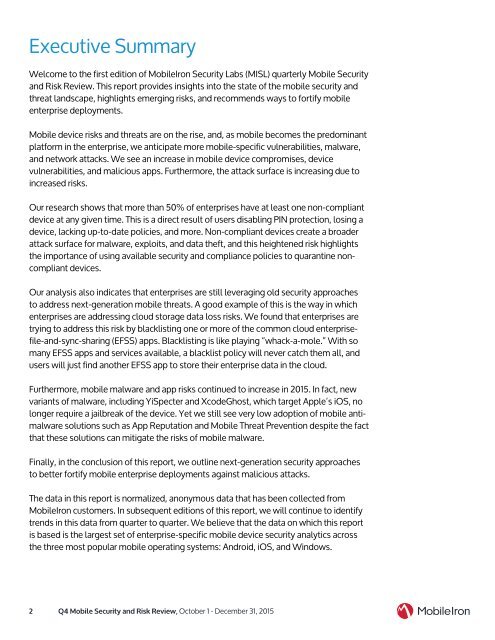Q4 Mobile Security and Risk Review
security-report-Q415-v1.2-EN
security-report-Q415-v1.2-EN
You also want an ePaper? Increase the reach of your titles
YUMPU automatically turns print PDFs into web optimized ePapers that Google loves.
Executive Summary<br />
Welcome to the first edition of <strong>Mobile</strong>Iron <strong>Security</strong> Labs (MISL) quarterly <strong>Mobile</strong> <strong>Security</strong><br />
<strong>and</strong> <strong>Risk</strong> <strong>Review</strong>. This report provides insights into the state of the mobile security <strong>and</strong><br />
threat l<strong>and</strong>scape, highlights emerging risks, <strong>and</strong> recommends ways to fortify mobile<br />
enterprise deployments.<br />
<strong>Mobile</strong> device risks <strong>and</strong> threats are on the rise, <strong>and</strong>, as mobile becomes the predominant<br />
platform in the enterprise, we anticipate more mobile-specific vulnerabilities, malware,<br />
<strong>and</strong> network attacks. We see an increase in mobile device compromises, device<br />
vulnerabilities, <strong>and</strong> malicious apps. Furthermore, the attack surface is increasing due to<br />
increased risks.<br />
Our research shows that more than 50% of enterprises have at least one non-compliant<br />
device at any given time. This is a direct result of users disabling PIN protection, losing a<br />
device, lacking up-to-date policies, <strong>and</strong> more. Non-compliant devices create a broader<br />
attack surface for malware, exploits, <strong>and</strong> data theft, <strong>and</strong> this heightened risk highlights<br />
the importance of using available security <strong>and</strong> compliance policies to quarantine noncompliant<br />
devices.<br />
Our analysis also indicates that enterprises are still leveraging old security approaches<br />
to address next-generation mobile threats. A good example of this is the way in which<br />
enterprises are addressing cloud storage data loss risks. We found that enterprises are<br />
trying to address this risk by blacklisting one or more of the common cloud enterprisefile-<strong>and</strong>-sync-sharing<br />
(EFSS) apps. Blacklisting is like playing “whack-a-mole.” With so<br />
many EFSS apps <strong>and</strong> services available, a blacklist policy will never catch them all, <strong>and</strong><br />
users will just find another EFSS app to store their enterprise data in the cloud.<br />
Furthermore, mobile malware <strong>and</strong> app risks continued to increase in 2015. In fact, new<br />
variants of malware, including YiSpecter <strong>and</strong> XcodeGhost, which target Apple’s iOS, no<br />
longer require a jailbreak of the device. Yet we still see very low adoption of mobile antimalware<br />
solutions such as App Reputation <strong>and</strong> <strong>Mobile</strong> Threat Prevention despite the fact<br />
that these solutions can mitigate the risks of mobile malware.<br />
Finally, in the conclusion of this report, we outline next-generation security approaches<br />
to better fortify mobile enterprise deployments against malicious attacks.<br />
The data in this report is normalized, anonymous data that has been collected from<br />
<strong>Mobile</strong>Iron customers. In subsequent editions of this report, we will continue to identify<br />
trends in this data from quarter to quarter. We believe that the data on which this report<br />
is based is the largest set of enterprise-specific mobile device security analytics across<br />
the three most popular mobile operating systems: Android, iOS, <strong>and</strong> Windows.<br />
2 <strong>Q4</strong> <strong>Mobile</strong> <strong>Security</strong> <strong>and</strong> <strong>Risk</strong> <strong>Review</strong>, October 1 - December 31, 2015






